Social Farming in the Virtuous System of the Circular Economy. An Exploratory Research
Abstract
1. Introduction and Theoretical Framework
- Hypothesis 1 (H1).Companies that carry out social agriculture in Calabria carry out eco-systemic services.
- Hypothesis 2 (H2).Does social farming provide circular economy services? Yes.
- H2a.In terms of good reuse practices, environmental education and food education laboratories, laboratories for fighting waste and recycling, reuse of waste products “from waste to resource”.
- H2b.In terms of good cultural practices: cultivation techniques such as rotation, absence of monocultures, organic production.
- Hypothesis 3 (H3).Social agriculture represents a form of resilience of Calabrian agricultural businesses (responses to new lifestyles, attention to green, use of confiscated land, and legal growth paths). They involve families, schools, institutions.
- Hypothesis 4 (H4).Social farming represents a connection between agricultural systems and urban systems.
- Hypothesis 5 (H5).Social farming provides educational and social inclusion community services.
- Hypothesis 6 (H6).Social farming provides community services of a therapeutic rehabilitation type (alternative/integration to families in support of disability).
- Hypothesis 7 (H7).Social farming provides support services to improve the quality of life and free time (well-being) for local and non-local subjects.
- Hypothesis 8 (H8).Social farming provides cultural and educational community services.
- Hypothesis 9 (H9).Social farming provides fresh and processed food production services.
- Hypothesis 10 (H10).Social farming adheres to SPG (Solidarity Purchase Groups) and Social Networks and unites and connects people, companies, and institutions.
2. Study Area
2.1. Description of the Socio-Economic Context
2.2. Social Farming in Calabria and the Reference Universe
3. Materials and Methods
3.1. Social Network Analysis (SNA)
3.2. Factor Analysis (FA) and Multiple Correspondence Analysis (MCA)
- on the one hand, the factors capable of explaining any differences that arise in the choice of different business behaviors and the ways in which technical-managerial skills and paths are developed
- on the other hand, identify the profile of the Social Farms on the basis of the choices made in the application/implementation of the multifunctionality directed at ecosystem services of social agriculture
3.3. Data Collection
- Social Work inclusion: aimed at people with disabilities and/or social disadvantages (handicapped, former alcoholics and/or former drug addicts, former prisoners, immigrants, long-term unemployed, women in difficulty, minors with various kinds of problems in working age, etc.) included in rehabilitation and social support projects (internships, work grants, training courses, care of public parks, social gardens, etc.). Social and work placement carried out on land confiscated from the organized crime (’ndrangheta).
- Green Care: benefits and services that flank and support medical, psychological, and rehabilitative therapies aimed at improving health conditions in mental health and wellbeing and social, emotional, and cognitive functions of people with physical and/or mental handicaps through therapeutic and rehabilitative paths with the landscape, crops, plants, and animals (pet Therapy, ortho-florotherapy, Forest therapy, etc.).
- Educational Activities: they promote services useful for daily life, welfare activities, and social support activities (day centers, recreational centers for the elderly, agri-nursery/agri-kindergarten). The didactic-educational activity is aimed at environmental and food education; safeguarding biodiversity; the dissemination of knowledge of the territory. Moreover workshops for education on legality and the common good; circular economy and food waste reduction workshops; workshops for the recovery of local crafts; cultural and recreational activities to help citizens rediscover peasant values and traditions; commitment and training camps, volunteering on land confiscated from organized crime (’ndrangheta). Last, but not least, schoolwork alternation, educational courses for children and/or teenagers in primary and secondary schools, cultural and recreational activities for adults, etc.
- Rural well-being: leisure services (e.g., agritourism, rural tourism, social tourism, agri-camping, hiking, nature trails, Yoga, wellness kits, guided tours, horseback riding, forest bathing, etc.);
- Agrifood and Marketing Innovation: production of raw materials or processed agricultural products; business; branding activities; promotion on social networks; e-commerce; catering;
- Community Network Collaboration to Local Action Groups, Alternative Food Networks, Purchasing Group, stakeholder network: adhesion to SGP and Network. Collaborations with public entities.
- -
- The starting year of the social agriculture activity
- -
- General and structural characteristics of businesses (type of business, crop orientation, salaried employment and family employment, corporate income on total income, etc.)
- -
- The reason for introducing new activities (activities suited to professionalism, new opportunities, and business innovation
- -
- Propensity for diversification
- -
- Propensity to introduce innovation (recent/consolidated introductions)
- -
- Degree of satisfaction with their work.
- -
- acquisition of technical skills in terms of training (possible attendance of courses and/or if you believe you need training courses)
- -
- economic support and contributions obtained
- -
- problem and conditioning (theft; threats, extortion; imposition of furniture and/or personnel; usury) and related behaviors (fear, denunciation, trust in institutions).
3.4. Approach Method
4. Results
4.1. The Social Network Analysis
4.2. Factorial Analysis and MCA
- -
- in the circle (positive dial for both dimensions) there are the companies that show to a greater extent a “social proper” profile (employment inclusion of fragile sections of the population, therapeutic services, and use of land confiscated from the ’ndrangheta). The inclusion of social activities pushes them towards a good degree of both diversification and innovation (identified by dimension two);
- -
- in the triangle (positive dial for dimension 2 and negative dial for the other) we identify the profile of companies that look in particular at “well-being and quality of life” (agritourism and excursions);
- -
- in the rectangle one finds the most common activities around the horizontal axis of the positive semi-axis with an “educational and social” profile and which have introduced interesting levels of marketing, product and/or process innovations, sales networks into the activities undertaken (online sales, SPG, Campagna Amica markets, etc.);
- -
- in the negative dial for both dimensions, there are companies that, while diversifying and joining the SF, have shown a “lukewarm” attitude and profile for almost all variables in the application of the various activities relating to Social Farming.
5. Discussion and Conclusions
Author Contributions
Funding
Institutional Review Board Statement
Informed Consent Statement
Data Availability Statement
Acknowledgments
Conflicts of Interest
Abbreviations
| SF | Social Farming |
| CSA | Community supported agriculture |
| AFN | Alternative Food Networks |
| SPG | Solidarity purchasing group |
| SNA | Social Network Analysis |
| FA | Factor Analysis |
| MCA | Multiple Correspondence Analysis |
| NBS | Nature-based solutions |
Appendix A
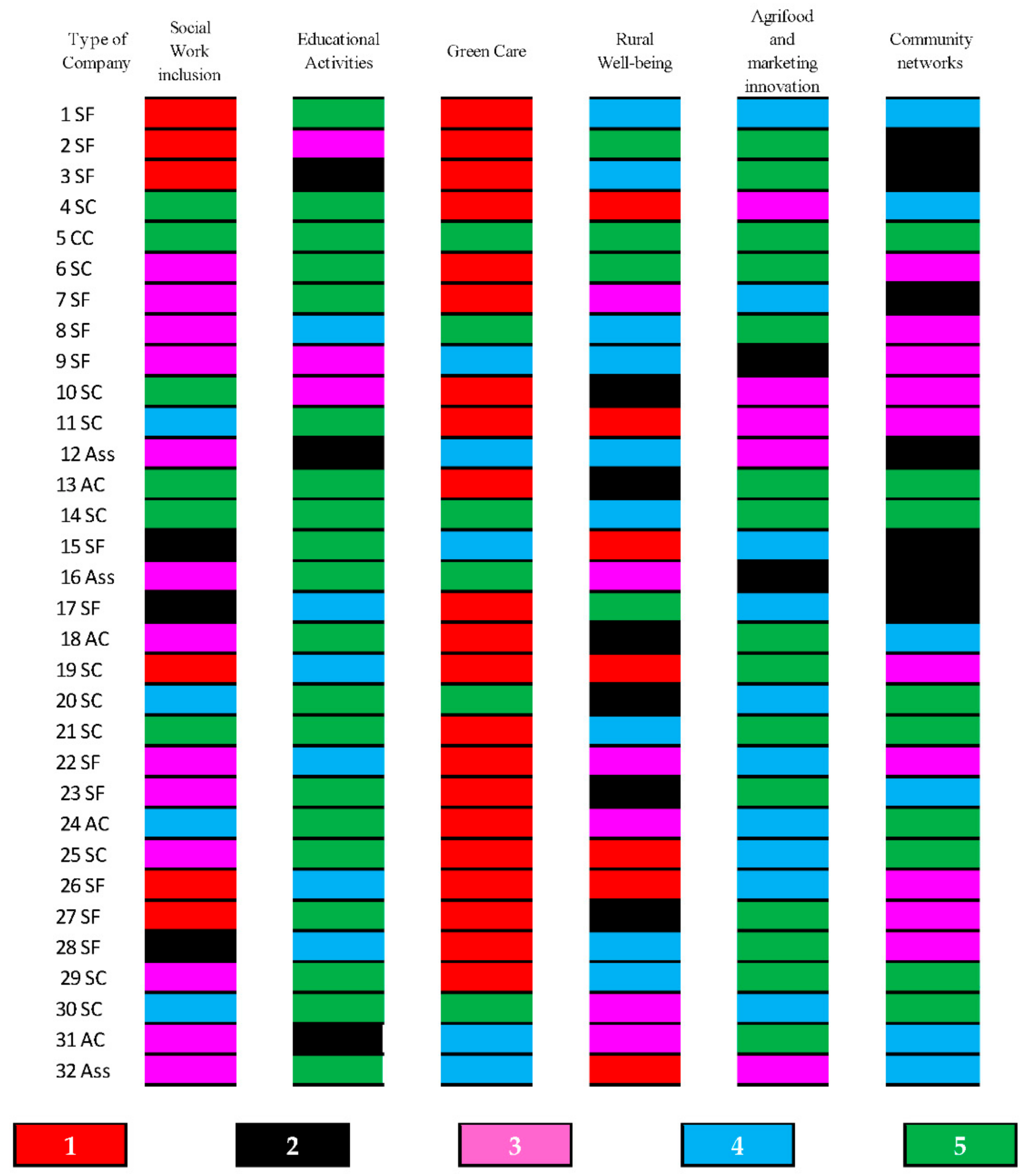
References
- A Farm to Fork Strategy for a Fair, Healthy and Environmentally-Friendly Food System. Available online: https://ec.europa.eu/food/sites/food/files/safety/docs/f2f_action-plan_2020_strategy-info_en.pdf (accessed on 18 September 2020).
- Muscio, A.; Sisto, R. Are Agri-Food Systems Really Switching to a Circular Economy Model? Implications for European Research and Innovation Policy. Sustainability 2020, 12, 5554. [Google Scholar] [CrossRef]
- Janker, J.; Mann, S.; Rist, S. Social sustainability in agriculture—A system-based framework. J. Rural Stud. 2019, 65, 32–42. [Google Scholar] [CrossRef]
- Di Iacovo, F. Agricoltura Sociale: Quando le Campagne Coltivano Valori; Franco Angeli: Milano, Italy, 2009. [Google Scholar]
- Supporting Policies for Social Farming in Europe: Progressing Multifunctionality in Responsive Riural Areas. Available online: http://sofar.unipi.it/index_file/book.htm (accessed on 8 November 2018).
- Di Iacovo, F. Agriculture and social sustainability. In Sustainability of the Agri-Food System, Strategies; Universitas Studiorum: Mantova, Italy, 2014. [Google Scholar]
- Overview of Social Farming and Rural Development Policy in Selected EU Member States, NRN Joint Thematic Initiative on Social Farming. Available online: https://enrd.ec.europa.eu/enrd-static/fms/pdf/A9746FA3-0D7E-1772-5CC7-11217C8EC059.pdf (accessed on 14 November 2018).
- Rapporto Sull’agricoltura Sociale in Italia; CREA-Rete Rurale. 2018. Available online: https://www.reterurale.it/flex/cm/pages/ServeBLOB.php/L/IT/IDPagina/18108 (accessed on 12 June 2018).
- Giarè, F.; Borsotto, P.; Signoriello, I. Social Farming in Italy. Analysis of an inclusive model. Soc. Ital. Rev. Agric. Econ. 2018, 73, 89–105. [Google Scholar]
- Scuderi, A.; Timpanaro, G.; Cacciola, S. Development policies for social farming in the EU-2020 Strategy. Suppl. Qual. Access Success J. 2014, 139, 76–82. [Google Scholar]
- European Commission (EC). Directorate—General for Research and Innovation, Public Procurement of Nature-Based Solutions; European Commission: Brussels, Belgium, 2020. [Google Scholar]
- PROFARM. Professional and Personal Empowerment in Social Fariming, Social Fariming in Europe. Available online: http://www.profarmproject.eu/2017. (accessed on 20 July 2019).
- Di Iacovo, F.; Moruzzo, R.; Rossignoli, C. Collaboration, knowledge and innovation toward a welfare society: The case of the Board of Social Farming in Valdera (Tuscany). J. Agric. Educ. Ext. 2017, 23, 289–311. [Google Scholar] [CrossRef]
- De Vivo, C.; Ascani, M.; Cacciola, S. Il budget di Salute Come Nuovo Strumento di Welare. In Proceedings of the XXXIX Conferenza Italiana di Scienze Regionali (A.I.S.Re): “Le regioni d’Europa tra identità locali, nuove comunità e disparità territoriali”, Bolzano, Italy, 17–19 September 2018. [Google Scholar]
- Izumi, B.; Wright, D.; Hamm, M. Market diversification and social benefits: Motivations of farmers participating farm to school programs. J. Rural Stud. 2010, 26, 374–382. [Google Scholar] [CrossRef]
- Garcìa-Llorente, M.; Rossignoli, C.M.; Di Iacovo, F.; Moruzzo, R. Social Farming in the Promotionn of Social-Ecological Sustainability in Rural and Periurban Areas. Sustainability 2016, 8, 1238. [Google Scholar] [CrossRef]
- Dell’Olio, M.; Hassink, J.; Vaandrager, L. The development of social farming in Italy: A qualitative inquiry across four regions. J. Rural Stud. 2017, 56, 65–75. [Google Scholar] [CrossRef]
- Genova, A.; Maccaroni, M.; Viganò, E. Social Farming: Heterogeneity in Social and Agricultural Relationships. Sustainability 2020, 12, 4824. [Google Scholar] [CrossRef]
- Tulla, A.F.; Vera, A.; Guirado, C.; Valldeperas, N. The Return on Investment in Social Farming: A Strategy for Sustainable Rural Development in Rural Catalonia. Sustainability 2020, 12, 4632. [Google Scholar] [CrossRef]
- Viganò, F.; Musolino, D. Agricoltura sociale come politica di sviluppo per le aree svantaggiate. Il caso del Mezzogiorno e della Calabria. In Perspektiven der Sozialen Landwirtschaft unter Besonderer Berücksichtigung der Entwicklungen in Italien Hrsg; Elsen, S., Angeli, S., Bernhard, A., Nicli, S., Eds.; Bozen-Bolzano University Press: Bolzano, Italy, 2020; pp. 177–190. [Google Scholar]
- Moruzzo, R.; Riccioli, F.; Galasso, A.; Troccoli, C.; Espinosa Diaz, S.; Di Iacovo, F. Italian Social Farming: The Network of Coldiretti and Campagna Amica. Sustainability 2020, 12, 5036. [Google Scholar] [CrossRef]
- Di Iacovo, F. Social Farming Evolutionary Web: From Public Intervention to Value Co-Production. Sustainability 2020, 12, 5269. [Google Scholar] [CrossRef]
- Guirado, C.; Valldeperas, N.; Tulla, A.F.; Sendra, L.; Badia, A.; Evard, C.; Cebollada, A.; Espluga, J.; Pallares, I.; Vera, A. Social farming in Catalonia: Rural local development, employment opportunities and empowerment for people at risk of social exclusion. J. Rural Stud. 2017, 56, 180–197. [Google Scholar] [CrossRef]
- Hassink, J.; Elings, M.; Zweekhorst, M.; Nieuwenhuizen, V.D.; Smit, N. Care farms in the Netherlands: Attractive empowerment-oriented and strengths-based practices in the community. Health Place 2010, 16, 423–430. [Google Scholar] [CrossRef]
- Hassink, J.; Hulsink, W.; Grinc, J.J. Farming with care: The evolution of care farming in the Netherlands. NJAS Wagening. J. Life Sci. 2014, 68, 1–11. [Google Scholar] [CrossRef]
- Haubenhofer, D.; Elings, M.; Hassink, J.; Hine, R. The Development of green care in Western European Countries. Explore 2010, 6, 106–111. [Google Scholar] [CrossRef]
- Steigen, A.; Kogstad, R.; Hummelvoll, J. Green Care Services in the Nordic countries: An integrative literature review. Eur. J. Soc. Work 2016, 19, 692–715. [Google Scholar] [CrossRef]
- Tulla, A.F.; Vera, A.; Valldeperas, N.; Guirado, C. New approaches to sustainable rural developement: Social farming as an opportunity in Europe? Hum. Geogr. J. Stud. Res. Hum. Geogr. 2017, 11, 25–40. [Google Scholar] [CrossRef]
- Borsotto, P.; Gaito, M.; Papaleo, A.; De Vivo, C.; Ascani, M.; Ricciardi, G.; Guccione, G.D. An exploratory study on the construction of networks in social farming. Econ. Agro Aliment. Food Econ. 2019, 21, 295–318. [Google Scholar] [CrossRef]
- Nelson, E.; Mendoza, G.; Regetz, J.; Polasky, S.; Tallis, H.; Cameron, D.; Chan, K.; Daily, G.; Goldstein, J.; Kareiva, P.; et al. Modeling multiple ecosystem services, biodiversity conservation. Front. Ecol. Environ. 2009, 7, 4–11. [Google Scholar] [CrossRef]
- Ascani, M.; Borsotto, P.; Guccione, G.D.; De Vivo, C.; Gaito, M.; Papaleo, A.R. Uno Studio Esplorativo Sulla Costruzione di Reti in Agricoltura Sociale, Rete Rurale Nazionale 2014–2020; CREA: Roma, Italy, 2020; pp. 1–24.
- ISTAT. Rapporto Competitività dei Settori Produttivi. 2018. Available online: https://www.istat.it/ (accessed on 18 September 2019).
- OECD. Science, Technology and Industry Scoreboard 2015: Innovation for Growth and Society; OECD Publishing: Paris, France, 2015; Available online: http://dx.doi.org/10.1787/sti_scoreboard-2015-en (accessed on 12 September 2019).
- SVIMEZ. L’impatto Economico e Sociale del Covid-19: Mezzogiorno e Centro-Nord. 2020. Available online: http://lnx.svimez.info/svimez/ (accessed on 8 October 2020).
- Banca d’Italia. Economie Regionali. L’economia Della Calabria. 2019. Available online: https://www.bancaditalia.it/ (accessed on 8 October 2020).
- Droli, M.; Radivo, G.G.; Iseppi, L. Does the establishment of a ‘forest therapy station’ in a low-mountain mixed hardwood forest make sense? In International Symposium: New Metropolitan Perspectives; Bevilacqua, C., Calabrò, F., Della Spina, L., Eds.; Springer: Berlin, Germany, 2021; pp. 67–79. [Google Scholar]
- Foley, R. Performing health in place: The holy well as a therapeutic assemblage. Health Place 2011, 2, 470–479. [Google Scholar] [CrossRef]
- Regione Calabria. Available online: https://www.regione.calabria.it/ (accessed on 22 January 2019).
- Nicolosi, A. L’utilizzo sociale dei beni confiscati alle mafie valori etici e opportunità occupazionali nelle cooperative sociali Libera Terra. In Produzioni Agroalimentari tra Rintracciabilità e Sicurezza: Analisi Economiche e Politiche di Intervento; Franco Angeli: Milano, Italy, 2009; pp. 407–422. [Google Scholar]
- Privitera, D.; Nicolosi, A. Comunità, Luoghi e Condivisione: Esplorazione di Modelli Alternative di Consumo; Franco Angeli: Milano, Italy, 2017; pp. 1–138. [Google Scholar]
- Di Gregorio, D.; Chiodo, A.P.; Nicolosi, A. Religious Fruition of the Territories: Ancient Traditions and New Trends in Aspromonte. In New Metropolitan Perspectives; ISHT 2018; Springer: Berlin, Germany, 2019; pp. 85–93. [Google Scholar]
- Arru, B.; Furesi, R.; Madau, F.M.; Pulina, P. “Value portfolio”, value creation and multifunctionality: The case study of an Italian wine agritourism farm. Aestimum 2020, 75, 163–181. [Google Scholar]
- Porter, M. Competitive Advantage of Nations. Compet. Intell. Rev. 1990, 68. [Google Scholar] [CrossRef]
- Kaldor, N. Economic Growth and the Verdoorn Law—A Comment on Mr Rowthorn’s Article. Econ. J. 1975, 85, 891–896. [Google Scholar] [CrossRef]
- Lo Re, M.; Meleo, L.; Pozzi, C. Strategicità del settore manifatturiero nei percorsi di crescita in chiave Kaldoriana. Un’applicazione della Network Analysis al caso Italia. L’industria 2015, 26, 473–490. [Google Scholar]
- Borgatti, S.; Everett, M.; Freeman, L. Ucinet for Windows: Software for Social Network Analysis; Analytic Technologies: Harvard, MA, USA, 2002. [Google Scholar]
- Enright, M. Regional clusters and Economic Development: A research agenda. In Business Networks: Prospects for Regional Development; de Gruyter, W., Staber, U.H., Eds.; De Gruyter: Berlin, Germany, 1996. [Google Scholar]
- Eraydın, A.; Fingleton, B. Network relations and local economic development: Some causes of differentiated network structures and intensities among Turkish industrial firms. Environ. Plan. A 2006, 6, 1171–1186. [Google Scholar] [CrossRef]
- Morone, P.; Sisto, R.; Taylor, R. Knowledge diffusion and geographical proximity: A multi-relational networks approach. Open Agric. 2019, 4, 129–138. [Google Scholar] [CrossRef]
- Scott, J. Social Network Analysis. A Handbook; SAGE Publications: London, UK, 2000. [Google Scholar]
- Wasserman, S.; Faust, K. Social Network Analysis: Methods and Applications; Cambridge University Press: Cambridge, UK, 1994. [Google Scholar]
- Greenacre, M. Theory and Applications of Correspondence Analysis; Academic Press: London, UK, 1984. [Google Scholar]
- Idda, L.; Madau, F.; Pulina, P. The Motivational Profile of Organic Food Consumers: A Survey of Specialized Stores Customers in Italy; Congress EAAE: Ghent, Belgium, 2008. [Google Scholar]
- Miralles, I.; Dentoni, D.; Pascucci, S. Understanding the organization of sharing economy in agri-food systems: Evidence from alternative food networks in Valencia. Agric. Hum. Values 2017, 34, 833–854. [Google Scholar] [CrossRef]
- Gioia, D.; Corley, K.; Hamilton, A. Seeking qualitative rigor in inductive research notes on the Gioia methodology. Organ. Res. Methods 2013, 1, 15–31. [Google Scholar] [CrossRef]
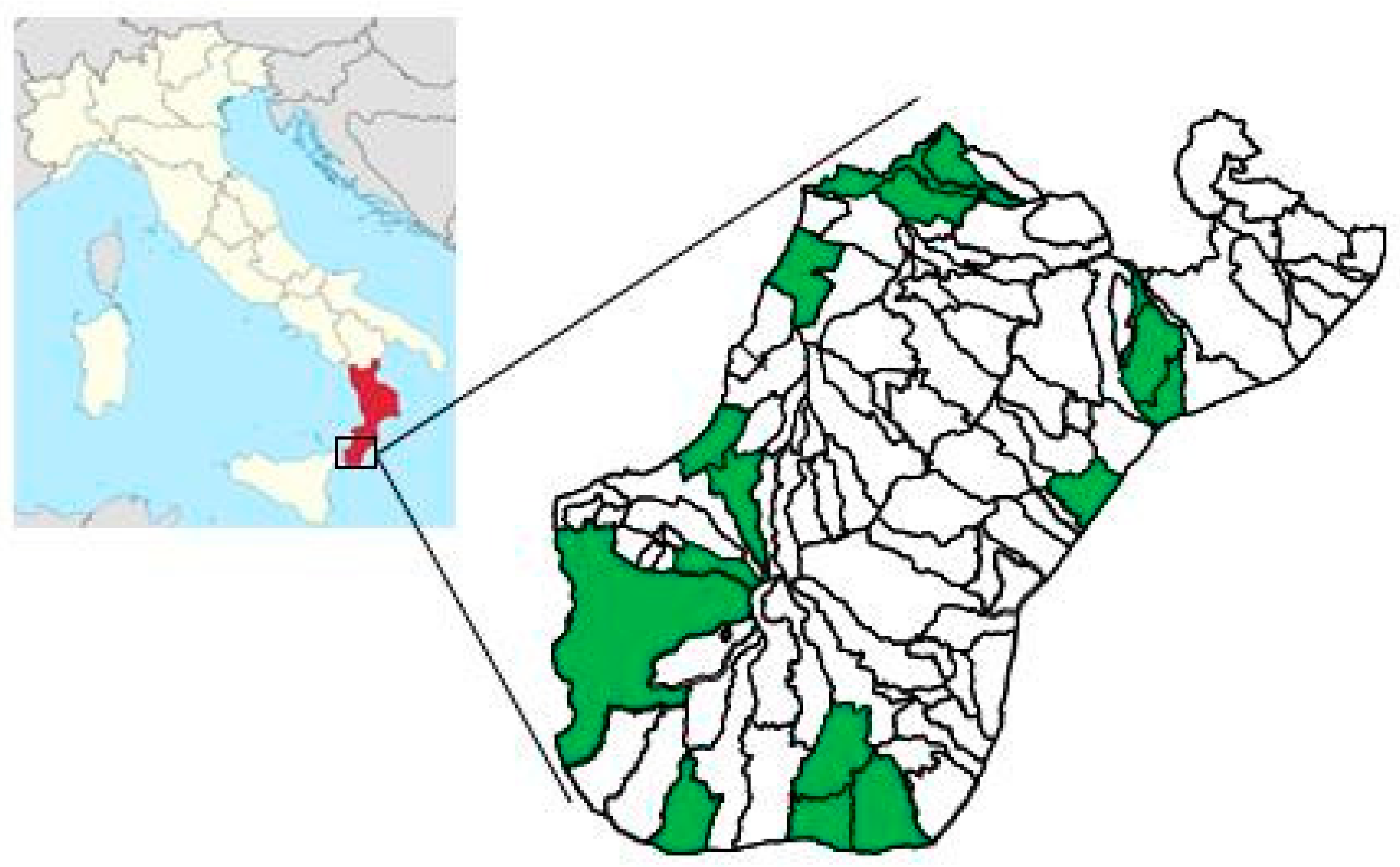
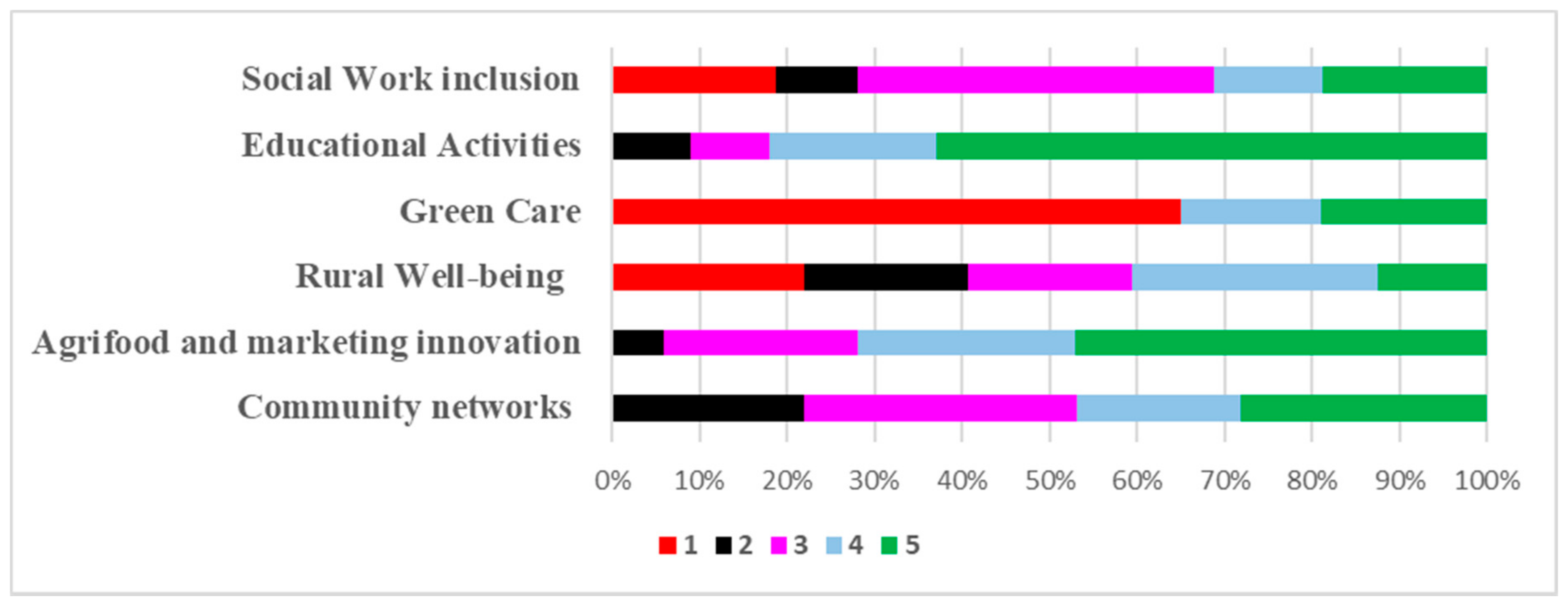
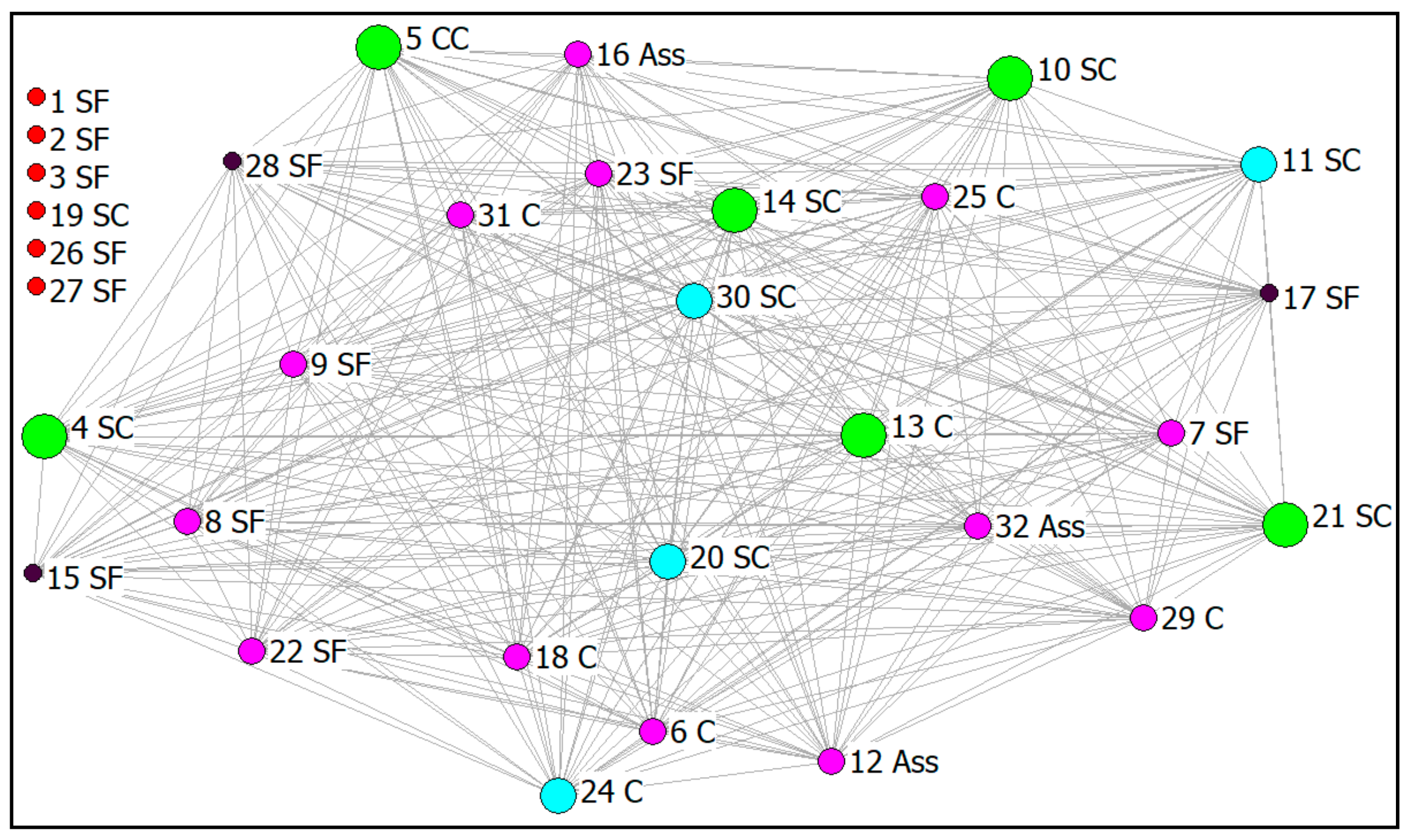
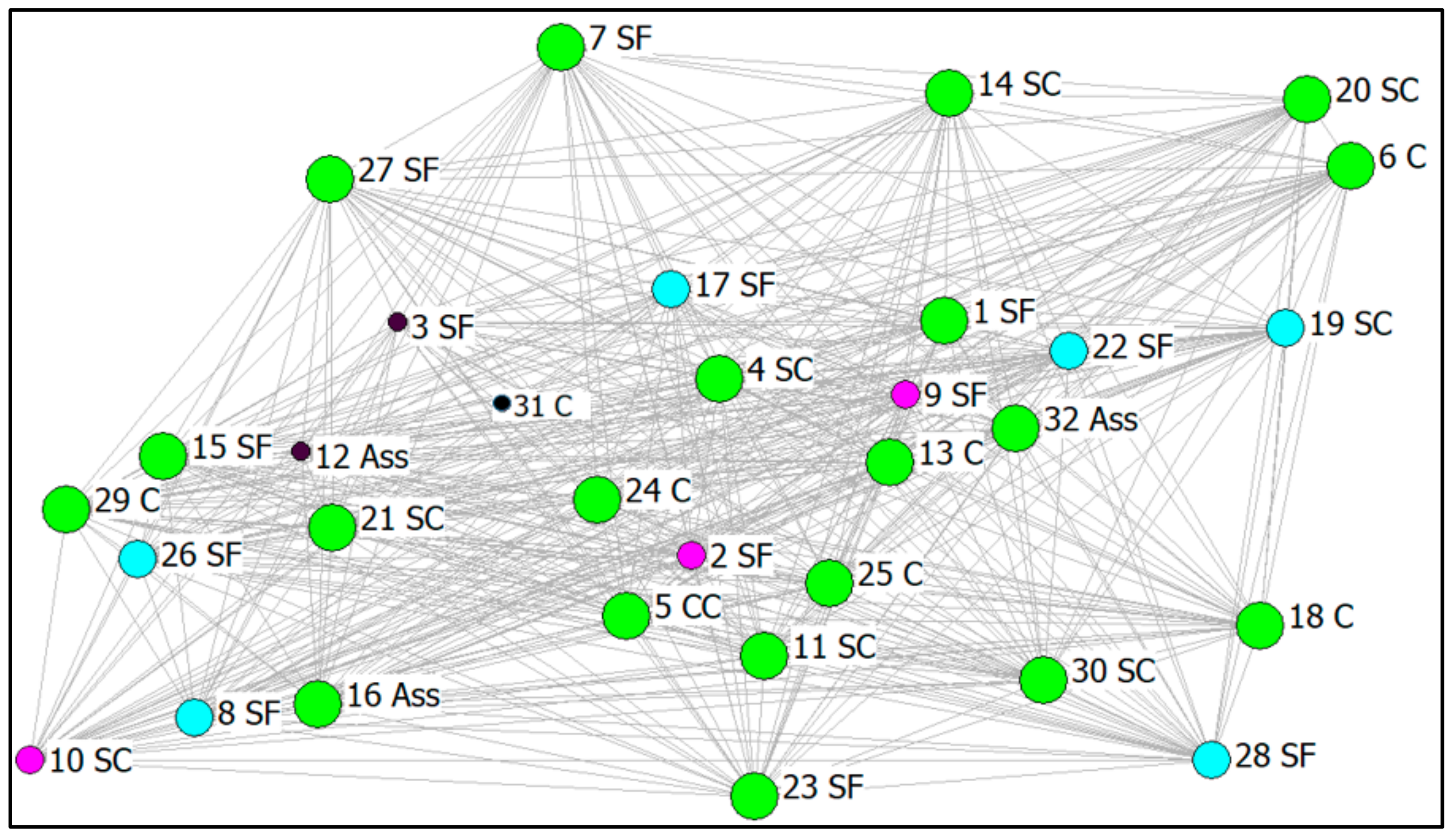
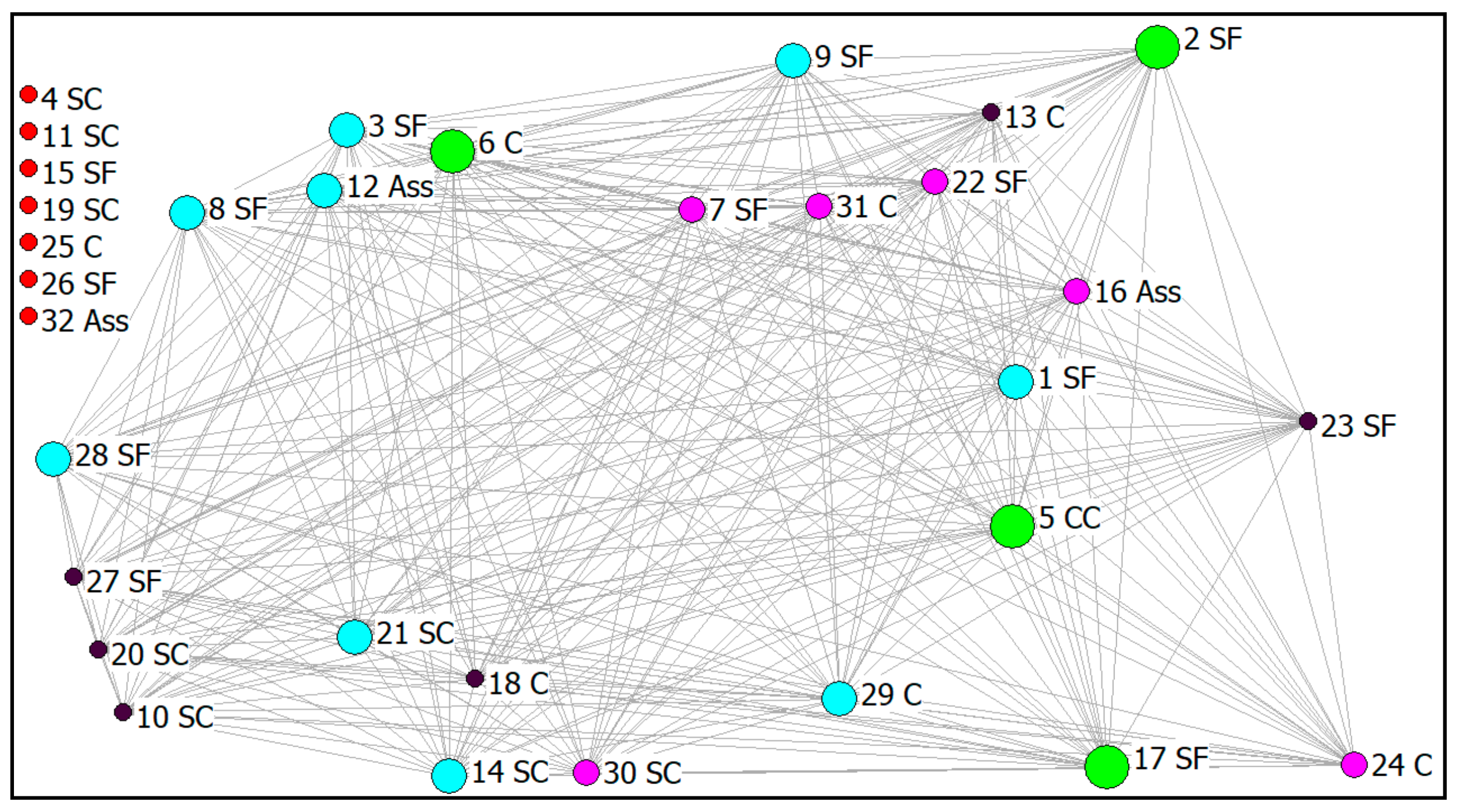
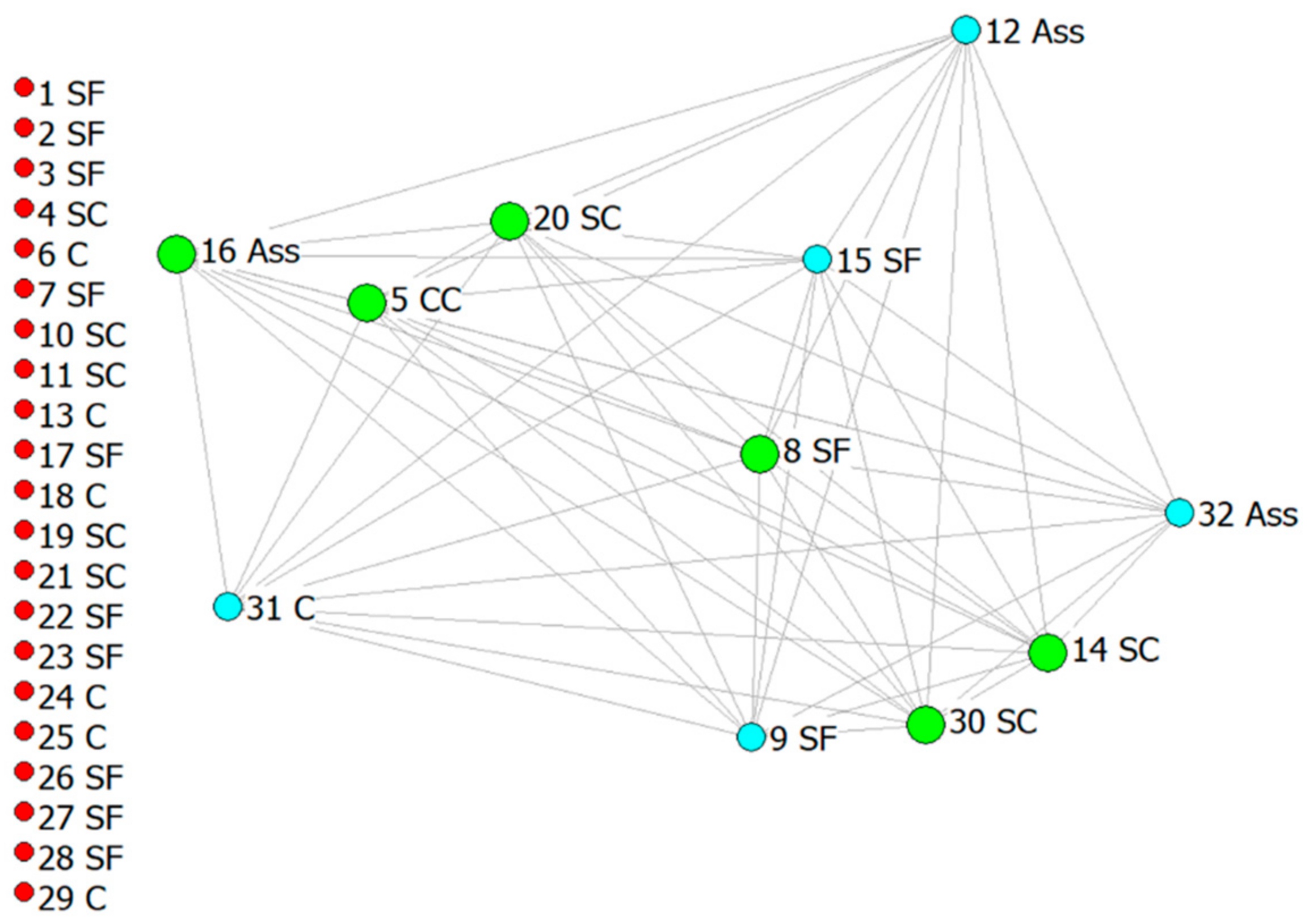

| Province | Reggio Calabria | 75.0% |
| Vibo Valentia | 6.3% | |
| Catanzaro | 15.6% | |
| Crotone | 3.1% | |
| Type of company | Individual business | 54.10% |
| Social cooperatives | 33.30% | |
| Agricultural cooperatives | 29.20% | |
| Associations | 12.50% | |
| Consortia of cooperatives | 4% | |
| Size | >di 100 ha | 12.50% |
| 50–100 ha | 9.40% | |
| 20–49 ha | 21.90% | |
| <20 ha | 56.30% | |
| Starting year of activity | 1990–1999 | 16.00% |
| 2000–2015 | 84.00% |
| 1. Social Work Inclusion: |
| Volunteer foster homes |
| Inclusion of migrants/disadvantaged |
| Inclusion of prisoners/former prisoners |
| Inclusion of people with disabilities/with addictions |
| Social worker inclusion in lands confiscated from the ’ndrangheta |
| Free social gardens and social gardens for rent |
| Other types of socio-working placement |
| 2. Green Care: |
| Pet therapy |
| Therapeutic gardens |
| Others (aromatherapy, phytotherapy, forest therapy, chromotherapy, etc.) |
| 3. Educational Activities |
| Welcoming families, schools, the elderly, groups (religious, sports, etc.) |
| Reception and volunteering for agricultural/agri-food activities |
| Educational lab on food education and the fight against waste |
| Educational lab on ethics and legal issues |
| Plants and sustainability educational lab |
| Local handicraft recovery lab |
| Other |
| 4. Rural Well-Being |
| Agritourism with accommodation |
| Agritourism, hospitality and catering |
| Agricamping |
| Excursions, nature trails |
| Ethical-social tourism |
| Yoga, wellness kits, guided tours, horseback riding, forest bathing |
| Other |
| 5. Agrifood and Marketing Innovation |
| Organic production |
| PDO—PGI quality marks |
| Ethical Trade Brands (Libera, SlowFood, fair trade, etc.) |
| Product and/or process certifications (ISO, etc.) |
| Reduced and easily differentiated packaging |
| Corporate social responsibility and ethics |
| Environmental sustainability certification, energy-saving certification |
| Innovations in agri-food production services |
| Innovations in agri-food marketing (e) |
| Short supply chain |
| E-commerce |
| Other |
| 6. Community Network |
| Collaboration with Local Action Groups, Purchasing Groups, CSA, AFN |
| Collaboration—Agreements with universities and research centers |
| Collaboration with other companies in the territory |
| Collaboration with social and health services |
| Membership of Cooperatives, Non-Profit Associations, Associations |
| Other |
| Variable | Relations with Research Hypotheses | Variable Name for MCA |
|---|---|---|
| Social Work inclusion | H1: Eco-systemic services H4: SF represents a connection between agricultural systems and urban systems H5: Community services of educational and social inclusion type | + Social Work inclusion; − Social Work inclusion |
| Green Care | H6: Social farming provides community services of a therapeutic rehabilitation type | + Green Care − Green Care |
| Educational Activities | H1: Eco-systemic services H8: Cultural and educational community services; welfare services H2: Educational labs and services of good practices of reuse and circular economy | + Educational Activities − Educational Activities |
| Rural well-being | H1: Eco-systemic services H7: Social farming provides support services to the quality of life and free time | + Rural well-being − Rural well-being |
| Agrifood and Marketing Innovation | H9: Social farming provides fresh and processed food production services H10: Social farming adheres to SPG (Solidarity Purchase Groups); AFN, etc H2: Good cultivation practices, organic production | + Marketing Innovation − Marketing Innovation |
| Community Network | H10: Social Networks and unite and connect people, companies, institutions H3: SF represents a form of resilience of Calabrian agricultural enterprises | + Community Network − Community Network |
| Use of confiscated land | H1: Eco-systemic services H3: SF represents a form of resilience of Calabrian agricultural enterprises H4: SF represents a connection between agricultural systems and urban systems H5: Community services of educational and social inclusion type | + Use of confiscated land − Use of confiscated land |
| Social Gardens | H5: Community services of educational and social inclusion type H4: SF represent a connection between agricultural systems and urban systems H9: Social farming provides fresh and processed food production services | + Social Gardens − Social Gardens |
| Workshop Food Waste | H1: Eco-systemic services H8: Cultural and educational community services; welfare services | + Workshop Food Waste − Workshop Food Waste |
| Sustainable Tourism | H7: Social farming provides support services to the quality of life and free time H4: SF represent a connection between agricultural systems and urban systems H3: SF represents a form of resilience of Calabrian agricultural enterprises | + Sustainable Tourism − Sustainable Tourism |
| Social Work Inclusion | Educational Activities | Green Care | Rural Well-Being | Agrifood and Marketing Innovation | Community Network | |||||||
|---|---|---|---|---|---|---|---|---|---|---|---|---|
| n. | % | n. | % | n. | % | n. | % | n. | % | n. | % | |
| 5. | 6 | 19 | 20 | 63 | 6 | 19 | 4 | 13 | 15 | 47 | 9 | 28 |
| 4. | 4 | 13 | 6 | 19 | 5 | 16 | 9 | 28 | 8 | 25 | 6 | 19 |
| 3. | 13 | 41 | 3 | 9 | 0 | 0 | 6 | 19 | 7 | 22 | 10 | 31 |
| 2. | 3 | 9 | 3 | 9 | 0 | 0 | 6 | 19 | 2 | 6 | 7 | 22 |
| 1. | 6 | 19 | 0 | 0 | 21 | 65 | 7 | 22 | 0 | 0 | 0 | 0 |
| Total | 32 | 100 | 32 | 100 | 32 | 100 | 32 | 100 | 32 | 100 | 32 | 100 |
| Companies | Nrm Out Degree % | Nrm In Degree % | ||
|---|---|---|---|---|
| Share of Relations out of the Total | Difference from the Overall Average | Share of Relations out of the Total | Difference from the Overall Average | |
| 1 SF | 41.9 | −1.8 | 80.6 | 36.9 |
| 2 SF | 32.3 | −11.5 | 12.9 | −30.8 |
| 3 SF | 32.3 | −11.5 | 12.9 | −30.8 |
| 4 SC | 48.4 | 4.6 | 35.5 | −8.3 |
| 5 CC | 25.8 | −17.9 | 100.0 | 56.3 |
| 6 SC | 67.7 | 24.0 | 51.6 | 7.9 |
| 7 SF | 58.1 | 14.3 | 29.0 | −14.7 |
| 8 SF | 29.0 | −14.7 | 83.9 | 40.1 |
| 9 SF | 12.9 | −30.8 | 3.2 | −40.5 |
| 10 SC | 29.0 | −14.7 | 9.7 | −34.1 |
| 11 SC | 29.0 | −14.7 | 9.7 | −34.1 |
| 12 Ass | 12.9 | −30.8 | 3.2 | −40.5 |
| 13 AC | 38.7 | −5.0 | 74.2 | 30.4 |
| 14 SC | 25.8 | −17.9 | 100.0 | 56.3 |
| 15 SF | 22.6 | −21.2 | 6.5 | −37.3 |
| 16 Ass | 22.6 | −21.2 | 6.5 | −37.3 |
| 17 SF | 32.3 | −11.5 | 12.9 | −30.8 |
| 18 AC | 71.0 | 27.2 | 61.3 | 17.5 |
| 19 SC | 58.1 | 14.3 | 29.0 | −14.7 |
| 20 SC | 48.4 | 4.6 | 83.9 | 40.1 |
| 21 SC | 48.4 | 4.6 | 87.1 | 43.3 |
| 22 SF | 58.1 | 14.3 | 29.0 | −14.7 |
| 23 SF | 71.0 | 27.2 | 61.3 | 17.5 |
| 24 AC | 48.4 | 4.6 | 35.5 | −8.3 |
| 25 SC | 71.0 | 27.2 | 61.3 | 17.5 |
| 26 SF | 58.1 | 14.3 | 29.0 | −14.7 |
| 27 SF | 58.1 | 14.3 | 29.0 | −14.7 |
| 28 SF | 67.7 | 24.0 | 51.6 | 7.9 |
| 29 SC | 41.9 | −1.8 | 74.2 | 30.4 |
| 30 SC | 48.4 | 4.6 | 83.9 | 40.1 |
| 31 AC | 38.7 | −5.0 | 19.4 | −24.4 |
| 32 Ass | 51.6 | 7.9 | 32.3 | −11.5 |
| Descriptive statistics | Nrm Out Degree | Nrm In Degree | ||
| Mean | 43.750 | 43.750 | ||
| Std Dev | 16.877 | 30.867 | ||
| Network Centralization (Out degree) = 28.096% | ||||
| Network Centralization (In degree) = 58.065% | ||||
| Component | Initial Eigenvalues | Extraction Sums of Squared Loadings | Rotation Sums of Squared Loadings | ||||||
|---|---|---|---|---|---|---|---|---|---|
| Total | % of Variance | Cumulative % | Total | % of Variance | Cumulative % | Total | % of Variance | Cumulative % | |
| 1 | 2.539 | 36.276 | 36.276 | 2.539 | 36.276 | 36.276 | 2.533 | 36.190 | 36.190 |
| 2 | 1.550 | 22.136 | 58.412 | 1.550 | 22.136 | 58.412 | 1.554 | 22.200 | 58.390 |
| 3 | 1.158 | 16.540 | 74.952 | 1.158 | 16.540 | 74.952 | 1.159 | 16.562 | 74.952 |
| 4 | 0.581 | 8.297 | 83.249 | ||||||
| 5 | 0.478 | 6.829 | 90.078 | ||||||
| 6 | 0.408 | 5.826 | 95.904 | ||||||
| 7 | 0.287 | 4.096 | 100.000 | ||||||
| Component | |||
|---|---|---|---|
| 1 | 2 | 3 | |
| Social Work Inclusion | 0.054 | 0.846 | −0.015 |
| Green Care | −0.037 | 0.821 | 0.060 |
| Educational Activities | −0.782 | −0.215 | −0.121 |
| Rural Well-being | −0.182 | −0.116 | −0.911 |
| Marketing Innovation | −0.618 | −0.240 | −0.554 |
| Community Network | −0.876 | −0.085 | −0.021 |
| Type of company | −0.857 | −0.201 | −0.055 |
| Dimension | Cronbach’s Alpha | Variance Accounted For | ||
|---|---|---|---|---|
| Total (Eigenvalue) | Inertia | % of Variance | ||
| 1 | 0.691 | 2.643 | 0.264 | 26.430 |
| 2 | 0.484 | 1.773 | 0.177 | 17.728 |
| Total | 4.416 | 0.442 | ||
| Mean | 0.608 a | 2.208 | 0.221 | 22.079 |
| Discrimination Measures | |||
|---|---|---|---|
| Dimension | Mean | ||
| 1 | 2 | ||
| Rural Well-being | 0.274 | 0.283 | 0.279 |
| Community Network | 0.530 | 0.001 | 0.265 |
| Sustainable Tourism | 0.139 | 0.200 | 0.169 |
| Social Work Inclusion | 0.034 | 0.632 | 0.333 |
| Workshop Food Waste | 0.432 | 0.078 | 0.255 |
| Educational Activities | 0.520 | 0.000 | 0.260 |
| Social Gardens | 0.267 | 0.161 | 0.214 |
| Green Care | 0.000 | 0.220 | 0.110 |
| Use of confiscated land | 0.343 | 0.195 | 0.269 |
| Marketing Innovation | 0.104 | 0.001 | 0.053 |
| Active Total | 2.643 | 1.773 | 2.208 |
| % of Variance | 26.430 | 17.728 | 22.079 |
Publisher’s Note: MDPI stays neutral with regard to jurisdictional claims in published maps and institutional affiliations. |
© 2021 by the authors. Licensee MDPI, Basel, Switzerland. This article is an open access article distributed under the terms and conditions of the Creative Commons Attribution (CC BY) license (http://creativecommons.org/licenses/by/4.0/).
Share and Cite
Nicolosi, A.; Laganà, V.R.; Di Gregorio, D.; Privitera, D. Social Farming in the Virtuous System of the Circular Economy. An Exploratory Research. Sustainability 2021, 13, 989. https://doi.org/10.3390/su13020989
Nicolosi A, Laganà VR, Di Gregorio D, Privitera D. Social Farming in the Virtuous System of the Circular Economy. An Exploratory Research. Sustainability. 2021; 13(2):989. https://doi.org/10.3390/su13020989
Chicago/Turabian StyleNicolosi, Agata, Valentina Rosa Laganà, Donatella Di Gregorio, and Donatella Privitera. 2021. "Social Farming in the Virtuous System of the Circular Economy. An Exploratory Research" Sustainability 13, no. 2: 989. https://doi.org/10.3390/su13020989
APA StyleNicolosi, A., Laganà, V. R., Di Gregorio, D., & Privitera, D. (2021). Social Farming in the Virtuous System of the Circular Economy. An Exploratory Research. Sustainability, 13(2), 989. https://doi.org/10.3390/su13020989








